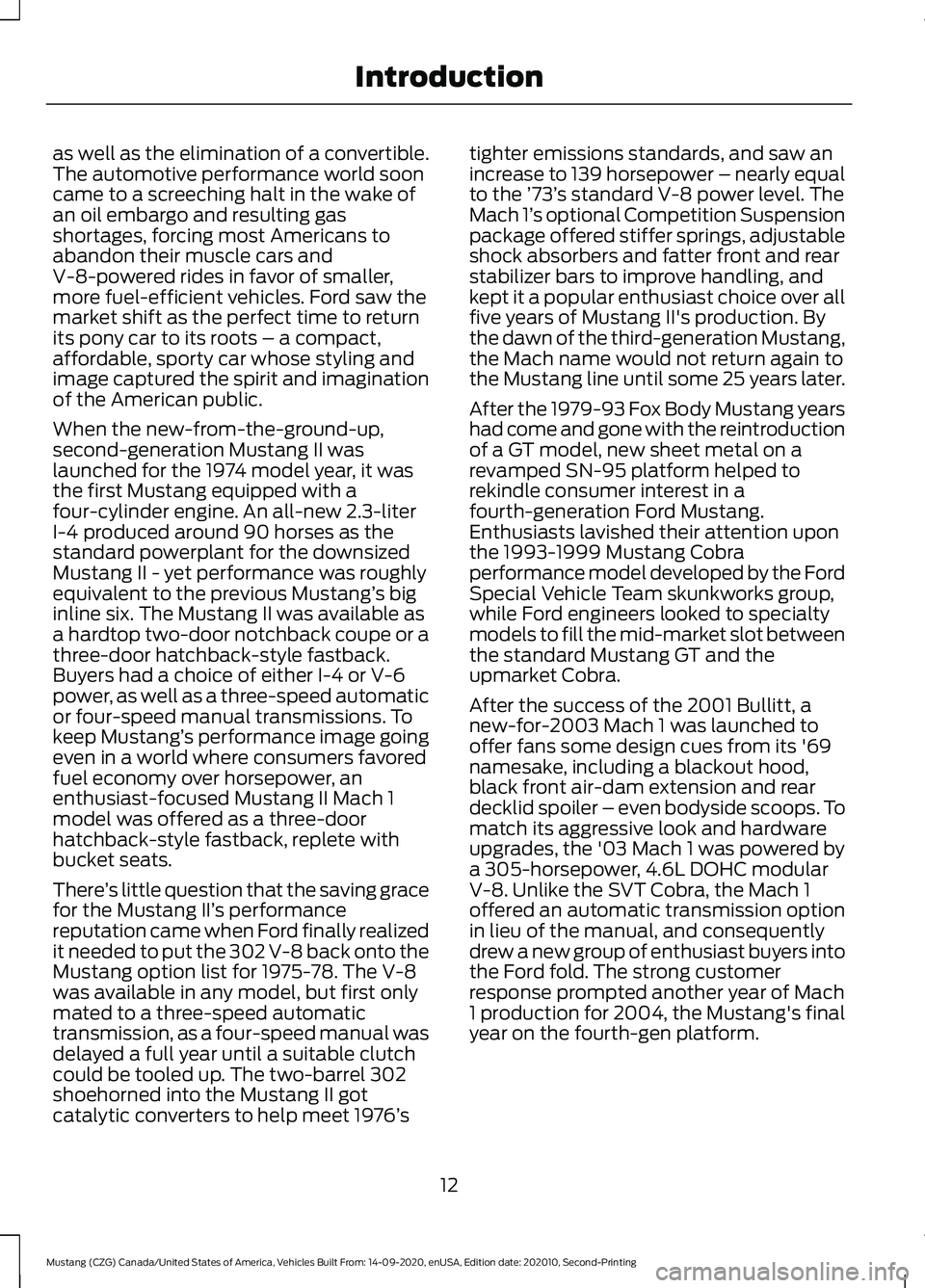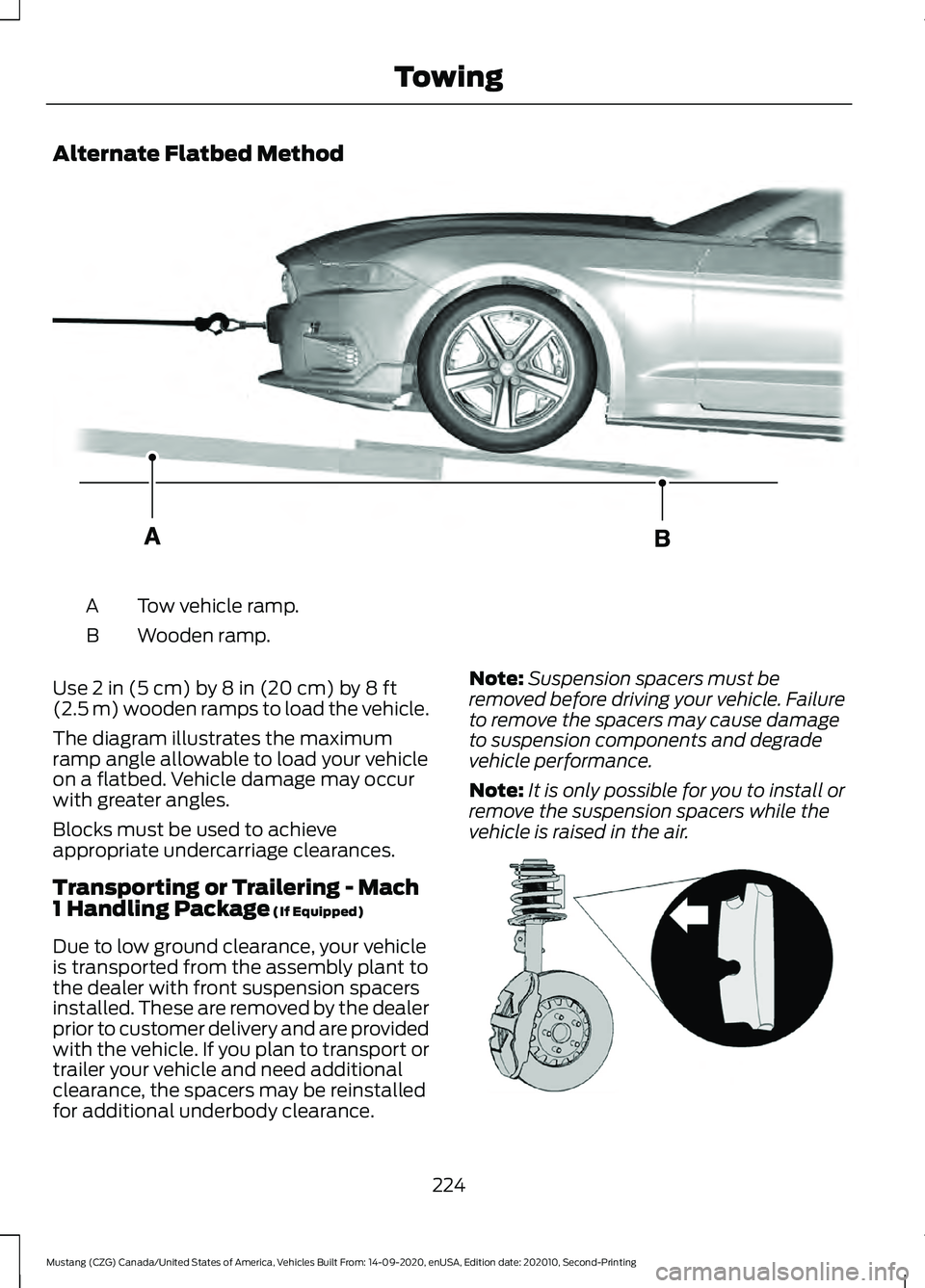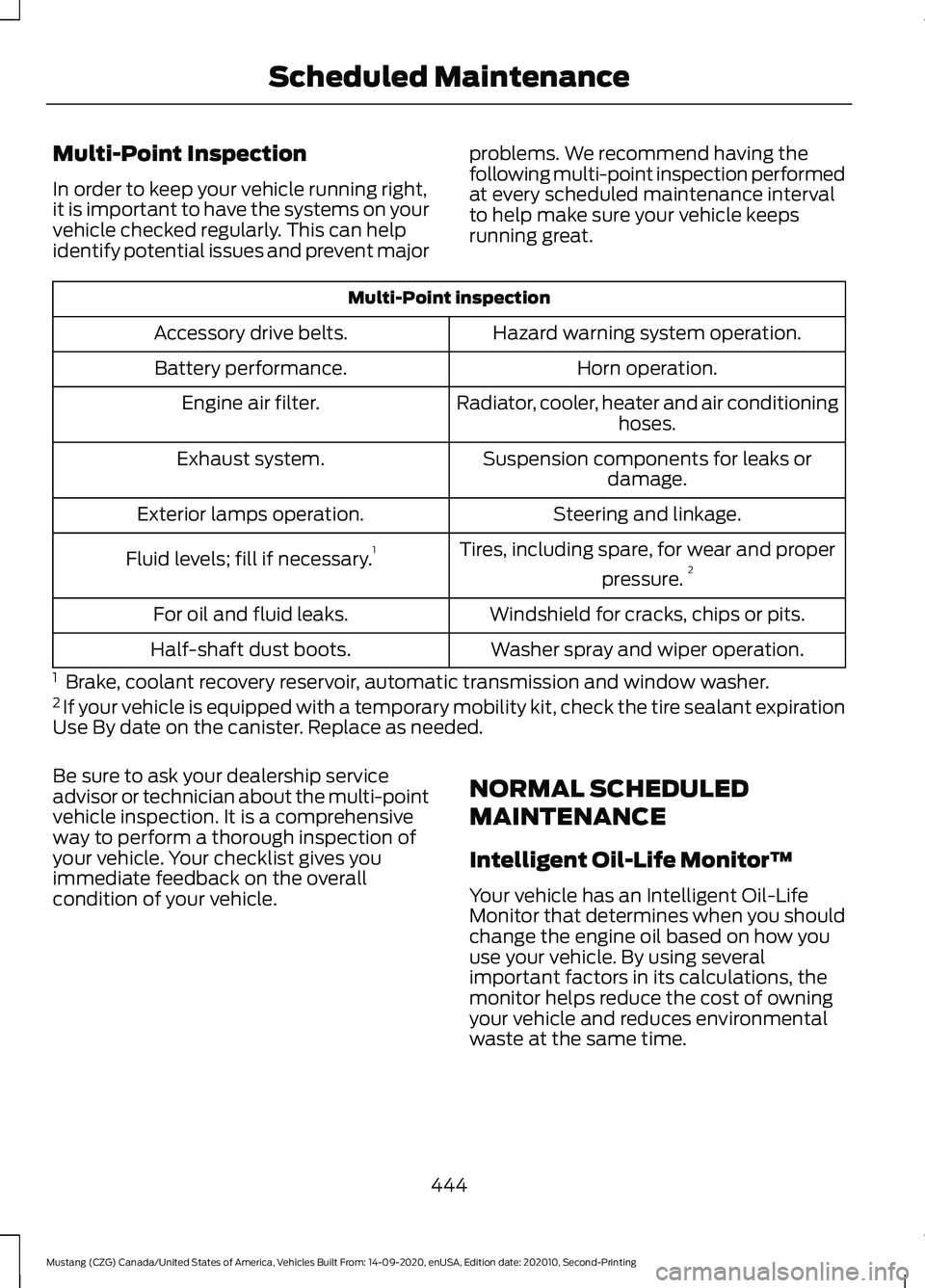2021 FORD MUSTANG air suspension
[x] Cancel search: air suspensionPage 15 of 530

as well as the elimination of a convertible.
The automotive performance world soon
came to a screeching halt in the wake of
an oil embargo and resulting gas
shortages, forcing most Americans to
abandon their muscle cars and
V-8-powered rides in favor of smaller,
more fuel-efficient vehicles. Ford saw the
market shift as the perfect time to return
its pony car to its roots – a compact,
affordable, sporty car whose styling and
image captured the spirit and imagination
of the American public.
When the new-from-the-ground-up,
second-generation Mustang II was
launched for the 1974 model year, it was
the first Mustang equipped with a
four-cylinder engine. An all-new 2.3-liter
I-4 produced around 90 horses as the
standard powerplant for the downsized
Mustang II - yet performance was roughly
equivalent to the previous Mustang’
s big
inline six. The Mustang II was available as
a hardtop two-door notchback coupe or a
three-door hatchback-style fastback.
Buyers had a choice of either I-4 or V-6
power, as well as a three-speed automatic
or four-speed manual transmissions. To
keep Mustang’ s performance image going
even in a world where consumers favored
fuel economy over horsepower, an
enthusiast-focused Mustang II Mach 1
model was offered as a three-door
hatchback-style fastback, replete with
bucket seats.
There ’s little question that the saving grace
for the Mustang II’ s performance
reputation came when Ford finally realized
it needed to put the 302 V-8 back onto the
Mustang option list for 1975-78. The V-8
was available in any model, but first only
mated to a three-speed automatic
transmission, as a four-speed manual was
delayed a full year until a suitable clutch
could be tooled up. The two-barrel 302
shoehorned into the Mustang II got
catalytic converters to help meet 1976 ’s tighter emissions standards, and saw an
increase to 139 horsepower – nearly equal
to the ’
73’s standard V-8 power level. The
Mach 1’ s optional Competition Suspension
package offered stiffer springs, adjustable
shock absorbers and fatter front and rear
stabilizer bars to improve handling, and
kept it a popular enthusiast choice over all
five years of Mustang II's production. By
the dawn of the third-generation Mustang,
the Mach name would not return again to
the Mustang line until some 25 years later.
After the 1979-93 Fox Body Mustang years
had come and gone with the reintroduction
of a GT model, new sheet metal on a
revamped SN-95 platform helped to
rekindle consumer interest in a
fourth-generation Ford Mustang.
Enthusiasts lavished their attention upon
the 1993-1999 Mustang Cobra
performance model developed by the Ford
Special Vehicle Team skunkworks group,
while Ford engineers looked to specialty
models to fill the mid-market slot between
the standard Mustang GT and the
upmarket Cobra.
After the success of the 2001 Bullitt, a
new-for-2003 Mach 1 was launched to
offer fans some design cues from its '69
namesake, including a blackout hood,
black front air-dam extension and rear
decklid spoiler – even bodyside scoops. To
match its aggressive look and hardware
upgrades, the '03 Mach 1 was powered by
a 305-horsepower, 4.6L DOHC modular
V-8. Unlike the SVT Cobra, the Mach 1
offered an automatic transmission option
in lieu of the manual, and consequently
drew a new group of enthusiast buyers into
the Ford fold. The strong customer
response prompted another year of Mach
1 production for 2004, the Mustang's final
year on the fourth-gen platform.
12
Mustang (CZG) Canada/United States of America, Vehicles Built From: 14-09-2020, enUSA, Edition date: 202010, Second-Printing Introduction
Page 227 of 530

Alternate Flatbed Method
Tow vehicle ramp.
A
Wooden ramp.
B
Use 2 in (5 cm) by 8 in (20 cm) by 8 ft
(2.5 m) wooden ramps to load the vehicle.
The diagram illustrates the maximum
ramp angle allowable to load your vehicle
on a flatbed. Vehicle damage may occur
with greater angles.
Blocks must be used to achieve
appropriate undercarriage clearances.
Transporting or Trailering - Mach
1 Handling Package
(If Equipped)
Due to low ground clearance, your vehicle
is transported from the assembly plant to
the dealer with front suspension spacers
installed. These are removed by the dealer
prior to customer delivery and are provided
with the vehicle. If you plan to transport or
trailer your vehicle and need additional
clearance, the spacers may be reinstalled
for additional underbody clearance. Note:
Suspension spacers must be
removed before driving your vehicle. Failure
to remove the spacers may cause damage
to suspension components and degrade
vehicle performance.
Note: It is only possible for you to install or
remove the suspension spacers while the
vehicle is raised in the air. 224
Mustang (CZG) Canada/United States of America, Vehicles Built From: 14-09-2020, enUSA, Edition date: 202010, Second-Printing TowingE333063 E343027
Page 322 of 530

If you feel a sudden vibration or
ride disturbance while driving, or
you suspect your tire or vehicle
has been damaged, immediately
reduce your speed. Drive with
caution until you can safely pull
off the road. Stop and inspect the
tires for damage. If a tire is
under-inflated or damaged,
deflate it, remove wheel and
replace it with your spare tire and
wheel. If you cannot detect a
cause, have the vehicle towed to
the nearest repair facility or tire
dealer to have the vehicle
inspected.
Tire and Wheel Alignment
A bad jolt from hitting a curb or
pothole can cause the front end
of your vehicle to become
misaligned or cause damage to
your tires. If your vehicle seems to
pull to one side when you’re
driving, the wheels may be out of
alignment. Have an authorized
dealer check the wheel alignment
periodically.
Wheel misalignment in the front
or the rear can cause uneven and
rapid treadwear of your tires and
should be corrected by an
authorized dealer. Front-wheel
drive vehicles and those with an
independent rear suspension (if
equipped) may require alignment
of all four wheels.
The tires should also be balanced
periodically. An unbalanced tire
and wheel assembly may result in
irregular tire wear.
Tire Rotation
Note:
If your tires show uneven
wear ask an authorized dealer to
check for and correct any wheel
misalignment, tire imbalance or
mechanical problem involved
before tire rotation.
Note: Your vehicle may be
equipped with a dissimilar spare
wheel and tire assembly. A
dissimilar spare wheel and tire
assembly is defined as a spare
wheel and tire assembly that is
different in brand, size or
appearance from the road tires and
wheels. If you have a dissimilar
spare wheel and tire assembly it is
intended for temporary use only
and should not be used in a tire
rotation.
Note: After having your tires
rotated, inflation pressure must be
checked and adjusted to the
vehicle requirements.
Rotating your tires at the
recommended interval (as
indicated in the Scheduled
Maintenance chapter) will help
your tires wear more evenly,
providing better tire performance
and longer tire life. Sometimes
irregular tire wear can be
corrected by rotating the tires.
Rear-wheel drive vehicles (front
tires on the left side of the
diagram).
Non-directional tires
319
Mustang (CZG) Canada/United States of America, Vehicles Built From: 14-09-2020, enUSA, Edition date: 202010, Second-Printing Wheels and Tires
Page 447 of 530

Multi-Point Inspection
In order to keep your vehicle running right,
it is important to have the systems on your
vehicle checked regularly. This can help
identify potential issues and prevent major
problems. We recommend having the
following multi-point inspection performed
at every scheduled maintenance interval
to help make sure your vehicle keeps
running great.Multi-Point inspection
Hazard warning system operation.
Accessory drive belts.
Horn operation.
Battery performance.
Radiator, cooler, heater and air conditioninghoses.
Engine air filter.
Suspension components for leaks ordamage.
Exhaust system.
Steering and linkage.
Exterior lamps operation.
Tires, including spare, for wear and properpressure.2
Fluid levels; fill if necessary. 1
Windshield for cracks, chips or pits.
For oil and fluid leaks.
Washer spray and wiper operation.
Half-shaft dust boots.
1 Brake, coolant recovery reservoir, automatic transmission and window washer.
2 If your vehicle is equipped with a temporary mobility kit, check the tire sealant expiration
Use By date on the canister. Replace as needed.
Be sure to ask your dealership service
advisor or technician about the multi-point
vehicle inspection. It is a comprehensive
way to perform a thorough inspection of
your vehicle. Your checklist gives you
immediate feedback on the overall
condition of your vehicle. NORMAL SCHEDULED
MAINTENANCE
Intelligent Oil-Life Monitor™
Your vehicle has an Intelligent Oil-Life
Monitor that determines when you should
change the engine oil based on how you
use your vehicle. By using several
important factors in its calculations, the
monitor helps reduce the cost of owning
your vehicle and reduces environmental
waste at the same time.
444
Mustang (CZG) Canada/United States of America, Vehicles Built From: 14-09-2020, enUSA, Edition date: 202010, Second-Printing Scheduled Maintenance
Page 449 of 530

At every oil change interval as indicated by the information display
1
Inspect the exhaust system and heat shields.
Inspect rear axle and U-joints. Lubricate if your vehicle has grease fittings.
Inspect the half-shaft boots.
Inspect the steering linkage, ball joints, suspension, tie-rod ends, driveshaft and U-joints.
Lubricate any areas with grease fittings.
Inspect the wheels and related components for abnormal noise, wear, looseness or
drag.
1 Do not exceed one year or 10,000 mi (16,000 km) between service intervals.
2 Reset the Intelligent Oil-Life Monitor after engine oil and filter changes. Brake Fluid Maintenance
1
Change the brake fluid. 2
Every three Years
1 Perform this maintenance item every three years. Do not exceed the designated time
for the interval.
2 Brake fluid servicing requires special equipment available at your authorized dealer. Other Maintenance Items
1
Replace the cabin air filter.
Every
20,000 mi
(32,000 km)
Replace the engine air filter.
Every
30,000 mi
(48,000 km)
Replace the spark plugs.
Every
100,000 mi
(160,000 km) Inspect the accessory drive belts. 2
Change the automatic transmission fluid and filter.
Every
150,000 mi
(240,000 km) Change the manual transmission fluid.
Replace the accessory drive belts.
446
Mustang (CZG) Canada/United States of America, Vehicles Built From: 14-09-2020, enUSA, Edition date: 202010, Second-Printing Scheduled Maintenance
Page 522 of 530

Headlamp Adjusting
See: Adjusting the Headlamps...................... 272
Headlamp Exit Delay.....................................81
Headrest See: Head Restraints......................................... 134
Head Restraints.............................................134 Adjusting the Head Restraint......................... 135
Front Seat Non-Adjustable Head Restraints ........................................................................\
...... 135
Tilting Head Restraints .................................... 136
Heated Exterior Mirrors...............................132
Heated Rear Window..................................132
Heating See: Climate Control.......................................... 127
Hill Start Assist
..............................................173
Switching the System On and Off................173
Using Hill Start Assist........................................ 173
Hints on Controlling the Interior Climate - Vehicles With: Automatic
Temperature Control
.................................131
Defogging the Side Windows in Cold
Weather............................................................. 132
General Hints......................................................... 131
Quickly Cooling the Interior.............................. 131
Quickly Heating the Interior............................. 131
Recommended Settings for Cooling............131
Recommended Settings for Heating............131
Hints on Controlling the Interior Climate - Vehicles With: Manual Temperature
Control...........................................................130
Defogging the Side Windows in Cold Weather.............................................................. 131
General Hints....................................................... 130
Quickly Cooling the Interior............................ 130
Quickly Heating the Interior............................ 130
Recommended Settings for Cooling..........130
Recommended Settings for Heating..........130
Vehicle Stationary for Extended Periods During Extreme High Ambient
Temperatures.................................................. 130
Hints on Driving With Anti-Lock Brakes..............................................................171
Hood Lock See: Opening and Closing the Hood..........256
Horn
......................................................................77
How Does the Garage Door Opener Work................................................................141 I
In California (U.S. Only)
............................239
Information Display Control - Vehicles With: SYNC 3.................................................76
Quick Action Menus............................................. 77
Information Display Control - Vehicles With: SYNC....................................................76
Information Displays....................................99 General Information - Mach 1.......................... 99
General Information - Vehicles With: 12.3 Inch Instrument Cluster Display
Screen............................................................... 109
General Information - Vehicles With: 4.2 Inch Instrument Cluster Display
Screen................................................................ 103
Information Messages
.................................113
Adaptive Cruise Control.................................... 113
Airbag....................................................................... 114
Alarm........................................................................\
114
Battery and Charging System......................... 114
Blind Spot Information and Cross Traffic Alert System..................................................... 115
Doors and Locks.................................................. 116
Drive Control.......................................................... 116
Electronic Stability Control.............................. 116
Engine...................................................................... 116
Exhaust Mode........................................................ 117
Fuel........................................................................\
.... 117
Hill Start Assist...................................................... 117
Keys and Passive Key.......................................... 117
Maintenance......................................................... 118
MyKey....................................................................... 119
Park Aid................................................................... 119
Park Brake............................................................. 120
Pre-Collision Assist............................................ 120
Rear Axle................................................................ 120
Remote Start........................................................ 120
Seats........................................................................\
. 121
Starting System ................................................... 121
Steering System.................................................. 122
Suspension System........................................... 122
Tire Mobility Kit.................................................... 122
Tire Pressure Monitoring System.................. 123
Traction Control................................................... 123
Transmission.........................................................123
Installing Child Restraints - Mach 1..........27 Rear Seat Delete................................................... 27
519
Mustang (CZG) Canada/United States of America, Vehicles Built From: 14-09-2020, enUSA, Edition date: 202010, Second-Printing Index
Page 527 of 530

Starting and Stopping the Engine..........147
General Information........................................... 147
Steering............................................................201 Adaptive Learning............................................. 202
Electric Power Steering.................................... 201
Steering Wheel Lock...................................148 Unlocking the Steering Wheel....................... 148
Steering Wheel................................................75
Storage Compartments.............................146
Sun Visors.........................................................88 Illuminated Vanity Mirror................................... 89
Supplementary Restraints System.........48 Principle of Operation........................................ 48
Suspension Specifications - Mach 1
.......................................................................339
Switching Automatic High Beam Control On and Off.....................................................84
Activating the Automatic High Beam Control................................................................ 84
Switching Cruise Control On and Off...................................................................184
Switching Cruise Control Off.........................184
Switching Cruise Control On.......................... 184
Switching the Heated Steering Wheel On and Off......................................................77
Symbols Glossary
...........................................13
SYNC™ 3........................................................392
General Information......................................... 392
SYNC™ 3 Troubleshooting......................425 Additional Information and
Assistance........................................................ 437
Apps........................................................................\
432
Navigation............................................................. 431
Personal Profiles................................................ 435
Phone..................................................................... 429
Resetting the System....................................... 437
USB and Audio................................................... 426
Voice Recognition.............................................. 425
Wi-Fi Connectivity............................................. 434
SYNC™ Applications and Services........................................................379
911 Assist............................................................... 379
SYNC Mobile Apps............................................. 381
SYNC™............................................................375 General Information.......................................... 375
SYNC™ Troubleshooting
.........................383 T
Technical Specifications
See: Capacities and Specifications............335
The Better Business Bureau (BBB) Auto Line Program (U.S. Only)
......................240
Tire Care..........................................................305
Glossary of Tire Terminology......................... 307
Information About Uniform Tire Quality Grading............................................................. 305
Information Contained on the Tire Sidewall........................................................... 308
Temperature A B C........................................... 306
Traction AA A B C.............................................. 306
Treadwear............................................................ 306
Tire Inflation When Punctured See: Tire Sealant and Inflator Kit................299
Tire Pressure Monitoring System
...........324
Changing Tires With a Tire Pressure
Monitoring System....................................... 325
Understanding Your Tire Pressure Monitoring System ...................................... 325
Tire Repair Kit See: Tire Sealant and Inflator Kit................299
Tire Sealant and Inflator Kit
....................299
First Stage: Inflating the Tire with Sealing
Compound and Air........................................ 301
General Information........................................ 300
Second Stage: Checking Tire Pressure........................................................... 303
Tips for Use of the Kit...................................... 300
What to Do After the Tire Has Been Sealed............................................................... 303
What to do When a Tire Is Punctured........301
Tires See: Wheels and Tires..................................... 299
Towing a Trailer - Mach 1............................218
Towing a Trailer.............................................218 Load Placement.................................................. 218
Towing the Vehicle on Four Wheels..........................................................225
Emergency Towing............................................ 225
Recreational Towing......................................... 225
Towing
..............................................................218
Track Use - Mach 1.......................................276 Acceleration Timer............................................. 277
Accelerometer..................................................... 277
524
Mustang (CZG) Canada/United States of America, Vehicles Built From: 14-09-2020, enUSA, Edition date: 202010, Second-Printing Index